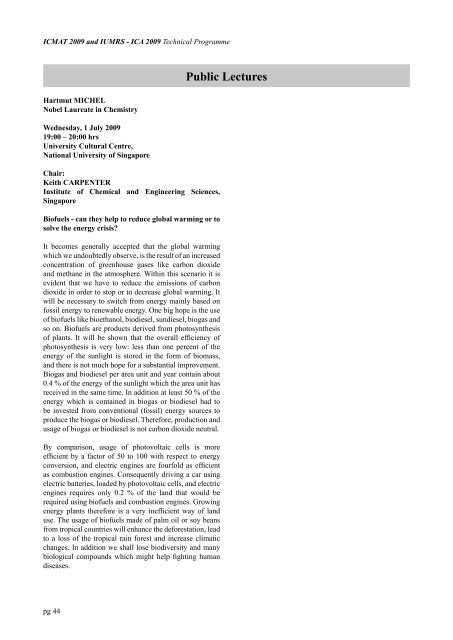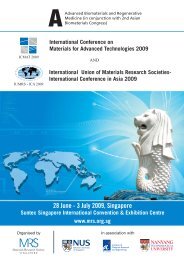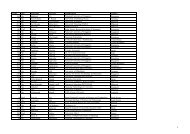Technical Programme - Materials Research Society of Singapore ...
Technical Programme - Materials Research Society of Singapore ...
Technical Programme - Materials Research Society of Singapore ...
Create successful ePaper yourself
Turn your PDF publications into a flip-book with our unique Google optimized e-Paper software.
ICMAT 2009 and IUMRS - ICA 2009 <strong>Technical</strong> <strong>Programme</strong><br />
Hartmut MICHEL<br />
Nobel Laureate in Chemistry<br />
Wednesday, 1 July 2009<br />
19:00 – 20:00 hrs<br />
University Cultural Centre,<br />
National University <strong>of</strong> <strong>Singapore</strong><br />
Chair:<br />
Keith CARPENTER<br />
Institute <strong>of</strong> Chemical and Engineering Sciences,<br />
<strong>Singapore</strong><br />
Bi<strong>of</strong>uels - can they help to reduce global warming or to<br />
solve the energy crisis?<br />
It becomes generally accepted that the global warming<br />
which we undoubtedly observe, is the result <strong>of</strong> an increased<br />
concentration <strong>of</strong> greenhouse gases like carbon dioxide<br />
and methane in the atmosphere. Within this scenario it is<br />
evident that we have to reduce the emissions <strong>of</strong> carbon<br />
dioxide in order to stop or to decrease global warming. It<br />
will be necessary to switch from energy mainly based on<br />
fossil energy to renewable energy. One big hope is the use<br />
<strong>of</strong> bi<strong>of</strong>uels like bioethanol, biodiesel, sundiesel, biogas and<br />
so on. Bi<strong>of</strong>uels are products derived from photosynthesis<br />
<strong>of</strong> plants. It will be shown that the overall effi ciency <strong>of</strong><br />
photosynthesis is very low: less than one percent <strong>of</strong> the<br />
energy <strong>of</strong> the sunlight is stored in the form <strong>of</strong> biomass,<br />
and there is not much hope for a substantial improvement.<br />
Biogas and biodiesel per area unit and year contain about<br />
0.4 % <strong>of</strong> the energy <strong>of</strong> the sunlight which the area unit has<br />
received in the same time. In addition at least 50 % <strong>of</strong> the<br />
energy which is contained in biogas or biodiesel had to<br />
be invested from conventional (fossil) energy sources to<br />
produce the biogas or biodiesel. Therefore, production and<br />
usage <strong>of</strong> biogas or biodiesel is not carbon dioxide neutral.<br />
By comparison, usage <strong>of</strong> photovoltaic cells is more<br />
effi cient by a factor <strong>of</strong> 50 to 100 with respect to energy<br />
conversion, and electric engines are fourfold as effi cient<br />
as combustion engines. Consequently driving a car using<br />
electric batteries, loaded by photovoltaic cells, and electric<br />
engines requires only 0.2 % <strong>of</strong> the land that would be<br />
required using bi<strong>of</strong>uels and combustion engines. Growing<br />
energy plants therefore is a very ineffi cient way <strong>of</strong> land<br />
use. The usage <strong>of</strong> bi<strong>of</strong>uels made <strong>of</strong> palm oil or soy beans<br />
from tropical countries will enhance the deforestation, lead<br />
to a loss <strong>of</strong> the tropical rain forest and increase climatic<br />
changes. In addition we shall lose biodiversity and many<br />
biological compounds which might help fi ghting human<br />
diseases.<br />
pg 44<br />
Public Lectures






